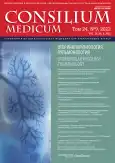Efficacy of herbal medicines in the treatment of acute respiratory infections in real clinical practice
- Authors: Svistushkin V.M.1, Nikiforova G.N.1, Shevchik E.A.1, Zolotova A.V.1, Nikiforova A.N.1, Sivokhin D.A.1
-
Affiliations:
- Sechenov First Moscow State Medical University (Sechenov University)
- Issue: Vol 24, No 9 (2022)
- Pages: 579-587
- Section: Articles
- URL: https://journals.rcsi.science/2075-1753/article/view/120371
- DOI: https://doi.org/10.26442/20751753.2022.9.201944
- ID: 120371
Cite item
Full Text
Abstract
Background. Unreasonable prescription of antibiotics to patients with acute diseases of the upper and lower respiratory tract is a significant problem of modern medicine, as it is associated with a high risk of side effects, an increase in antibiotic resistance and high economic costs. Phytopreparations can help reduce the frequency of inadequate antibiotic prescribing.
Aim. To study the effect of the use of herbal medicines on changing the frequency of prescribing antibiotic drugs to patients with infectious respiratory pathology. In addition, the presence of a relationship between the appointment of phytopreparations and the duration of the course of the infectious and inflammatory process was determined.
Materials and methods. Materials from the IMS® Disease Analyze database were analyzed. The study included patients who were diagnosed with acute respiratory infection between January 2015 and March 2019. According to the prescribed treatment, patients were divided into two groups: the main one, whose patients were prescribed phytopreparations as therapy, and the control group without the appointment of similar treatment. Patients who were prescribed antibiotics on the day of diagnosis were excluded from the study. To assess the relationship between the prescription of phytopreparations, antibiotics and the duration of the period of temporary disability, the logical regression method was used.
Results. The first group included 117 182 patients who used herbal medicines. In the control – the same number of patients without the appointment of phytopreparations. The following results were obtained: the use of phytopreparations was accompanied by a rarer additional prescription of antibiotics in the process of treatment, the duration of the period of temporary disability in the main group was shorter.
Conclusion. The use of phytopreparations in acute respiratory infections statistically significantly causes a decrease in the frequency of prescribing systemic antibiotics and a decrease in the duration of the period of temporary disability.
Full Text
##article.viewOnOriginalSite##About the authors
Valery M. Svistushkin
Sechenov First Moscow State Medical University (Sechenov University)
Email: svvm3@yandex.ru
ORCID iD: 0000-0001-7414-1293
D. Sci. (Med.), Prof.
Russian Federation, MoscowGalina N. Nikiforova
Sechenov First Moscow State Medical University (Sechenov University)
Author for correspondence.
Email: gn_nik_63@mail.ru
ORCID iD: 0000-0002-8617-0179
D. Sci. (Med.)
Russian Federation, MoscowElena A. Shevchik
Sechenov First Moscow State Medical University (Sechenov University)
Email: shevchik_e_a@staff.sechenov.ru
ORCID iD: 0000-0002-0051-3792
Cand. Sci. (Med.)
Russian Federation, MoscowAnna V. Zolotova
Sechenov First Moscow State Medical University (Sechenov University)
Email: zolotova_a_v@staff.sechenov.ru
ORCID iD: 0000-0002-3700-7367
Cand. Sci. (Med.)
Russian Federation, MoscowAnna N. Nikiforova
Sechenov First Moscow State Medical University (Sechenov University)
Email: james.ann@mail.ru
ORCID iD: 0000-0001-8850-004X
Student
Russian Federation, MoscowDmitrii A. Sivokhin
Sechenov First Moscow State Medical University (Sechenov University)
Email: gn_nik_63@mail.ru
ORCID iD: 0000-0001-7341-1167
Graduate Student
Russian Federation, MoscowReferences
Supplementary files











